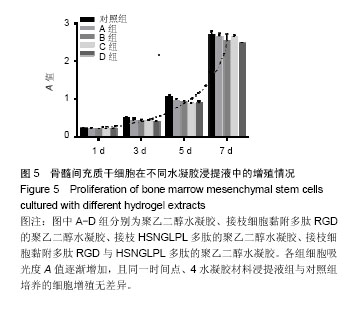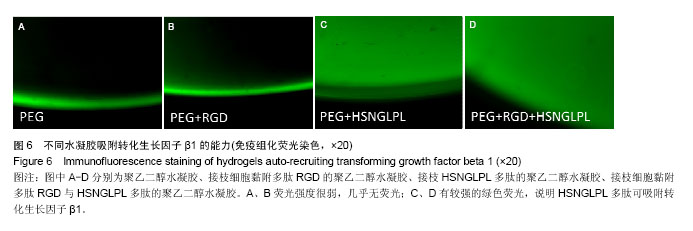| [1] Kevadiya BD,Rajkumar S,Bajaj HC,et al.Biodegradable gelatin-ciprofloxacin-montmorillonite composite hydrogels for controlled drug release and wound dressing application. Colloids Surf B Biointerfaces.2014;122:175-183.[2] Arica MY,Bayramoglu G,Arica B,et al.Novel hydrogel membrane based on copoly(hydroxyethyl methacrylate/ p-vinylbenzyl-poly(ethylene oxide)) for biomedical applications: properties and drug release characteristics. Macromol Biosci.2005;5(10):983-992.[3] Donnelly RF,Moffatt K,Alkilani AZ,et al.Hydrogel-forming microneedle arrays can be effectively inserted in skin by self-application: a pilot study centred on pharmacist intervention and a patient information leaflet.Pharm Res. 2014;31(8):1989-1999. [4] Amini AA,Nair LS.Injectable hydrogels for bone and cartilage repair.Biomed Mater. 2012;7(2):024105. [5] Osada KKataoka K.Drug and Gene Delivery Based on Supramolecular Assembly of PEG-Polypeptide Hybrid Block Copolymers.Adv Polym Sci.2006;202(1):113-153.[6] Elisseeff J,Anseth K,Sims D,et al.Transdermal photopolymerization of poly(ethylene oxide)-based injectable hydrogels for tissue-engineered cartilage.Plast Reconstr Surg.1999;104(4):1014-1022.[7] Demerlis CC,Schoneker DR.Review of the oral toxicity of polyvinyl alcohol (PVA).Food Chem Toxicol. 2003;41(3): 319-326.[8] Bodugoz-Senturk H,Macias CE,Kung JH,et al.Poly(vinyl alcohol)-acrylamide hydrogels as load-bearing cartilage substitute.Biomaterials.2008;30(4):589-596.[9] Kobayashi M,Oka M.Characterization of a polyvinyl alcohol-hydrogel artificial articular cartilage prepared by injection molding.J Biomater Sci Polym Ed. 2004;15(15): 741-751.[10] Zhai NH,An LI,Wang AQ.Pilot-plant Test for Synthesis of Poly(acrylic acid)/Attapulgite Superabsorbent Composite.Fine Chem.2006;23(3):215-217.[11] Peracchia MT,Gref R,Minamitake Y,et al.PEG-coated nanospheres from amphiphilic diblock and multiblock copolymers: Investigation of their drug encapsulation and release characteristics 1.J Control Release. 1997;46(3): 223-231.[12] Revzin A,And RG,Toner M.Surface Engineering with Poly(ethylene glycol) Photolithography to Create High-Density Cell Arrays on Glass.Langmuir. 2003;19(23): 9855-9862.[13] Zhu J,Beamish JA,Tang C,et al.Extracellular Matrix-like Cell-Adhesive Hydrogels from RGD-Containing Poly(ethylene glycol) Diacrylate.Macromolecules.2006;39(4):1305-1307.[14] Ruan G,Feng SS.Preparation and characterization of poly(lactic acid)-poly(ethylene glycol)-poly(lactic acid) (PLA-PEG-PLA) microspheres for controlled release of paclitaxel. Biomaterials.2003;24(27):5037-5044.[15] Chen W,Chen S,Morsi Y,et al.Superabsorbent 3D Scaffold Based on Electrospun Nanofibers for Cartilage Tissue Engineering.ACS Appl Mater Interfaces. 2016;8(37): 24415-24425. [16] 罗晓燕,尹玉姬,娄翔,等.水凝胶在组织工程中的应用进展[J].天津工业大学学报,2004,23(4):88-93.[17] Ruoslahti E.RGD and other recognition sequences for integrins.Ann Rev Cell Dev Biol.1996;12(12):697.[18] Zhan C,Gu B,Xie C,et al.Cyclic RGD conjugated poly(ethylene glycol)- co -poly(lactic acid) micelle enhances paclitaxel anti-glioblastoma effect.J Control Release. 2010; 143(1):136-142. [19] Burdick JA,Anseth KS.Photoencapsulation of osteoblasts in injectable RGD-modified PEG hydrogels for bone tissue engineering.Biomaterials.2002;23(22):4315-4323.[20] 张云燕,石雪蓉.转化生长因子β的研究进展[J].四川解剖学杂志, 2006,14(3):30-32.[21] Seko Y,Seko Y,Takahashi N,et al.Pulsatile stretch stimulates vascular endothelial growth factor (VEGF) secretion by cultured rat cardiac myocytes.Biochem Biophys Res Commun.1999;254(2):462-465.[22] Sanchez-Capelo A.Dual role for TGF-β1 in apoptosis. Cytokine Growth Factor Rev.2005;16(1):15-34.[23] Shah RN,Langer R.Regenerative Medicine Special Feature: Supramolecular design of self-assembling nanofibers for cartilage regeneration.Proc Nat Acad Sci. 2010;107(8): 3293-3298.[24] Crispim J,Fernandes HA,Fu SC,et al.TGF-β1 activation in human hamstring cells through growth factor binding peptides on polycaprolactone surfaces.Acta Biomaterialia. 2017;53: 165-178. [25] Kingshott P,Thissen H,Griesser HJ. Effects of cloud-point grafting, chain length, and density of PEG layers on competitive adsorption of ocular proteins.Biomaterials. 2002; 23(9):2043-2056.[26] Mai-Ngam K.Comblike poly(ethylene oxide)/hydrophobic C6 branched chitosan surfactant polymers as anti-infection surface modifying agents.Colloids Surf B Biointerfaces. 2006; 49(2):117-125. [27] Nemir S,Hayenga HN,West JL.PEGDA hydrogels with patterned elasticity: Novel tools for the study of cell response to substrate rigidity.Biotechnol Bioeng.2010;105(3):636-644. [28] Cai L,Lu J,Sheen V,et al.Optimal poly(L-lysine) grafting density in hydrogels for promoting neural progenitor cell functions.Biomacromolecules.2012;13(5):1663-1674. [29] Aimetti AA,Machen AJ,Anseth KS.Poly(ethylene glycol) hydrogels formed by thiol-ene photopolymerization for enzyme-responsive protein delivery.Biomaterials. 2009; 30(30):6048-6054.[30] Cuchiara MP,Allen AC,Chen TM,et al.Multilayer microfluidic PEGDA hydrogels.Biomaterials.2010;31(21):5491.[31] 陈元仲,吴勇,陈萍,等.白血病细胞TGF-β1含量减少及外源性TGF-β1基因对HL-60细胞的作用[J].中国病理生理杂志, 2006, 22(1):172-176.[32] Papadimitriou A,Peixoto EB,Silva KC,et al.Increase in AMPK brought about by cocoa is renoprotective in experimental diabetes mellitus by reducing NOX4/TGFβ-1 signaling.J Nutr Biochem. 2014;25(7):773-784. [33] Yoon HJ,Kim SB,Somaiya D,et al.Type II collagen and glycosaminoglycan expression induction in primary human chondrocyte by TGF-β1.BMC Musculoskelet Disord. 2015;16: 141. [34] Elmorsy S,Funakoshi T,Sasazawa F,et al.Chondroprotective effects of high-molecular-weight cross-linked hyaluronic acid in a rabbit knee osteoarthritis model.Osteoarthritis Cartilage. 2014;22(1):121-127.[35] Toffoli B,Pickering RJ,Tsorotes D,et al.Osteoprotegerin promotes vascular fibrosis via a TGF-β1 autocrine loop. Atherosclerosis.2011;218(1):61-68.[36] Katsura T,Tohyama H,Kondo E,et al.Effects of administration of transforming growth factor (TGF)-beta1 and anti-TGF-beta1 antibody on the mechanical properties of the stress-shielded patellar tendon.J Biomech. 2006;39(14): 2566-2572.[37] 段世锋.组织工程水凝胶引发体系的细胞毒性和生物活性化的初步研究[D].复旦大学,2005. |
.jpg)






.jpg)